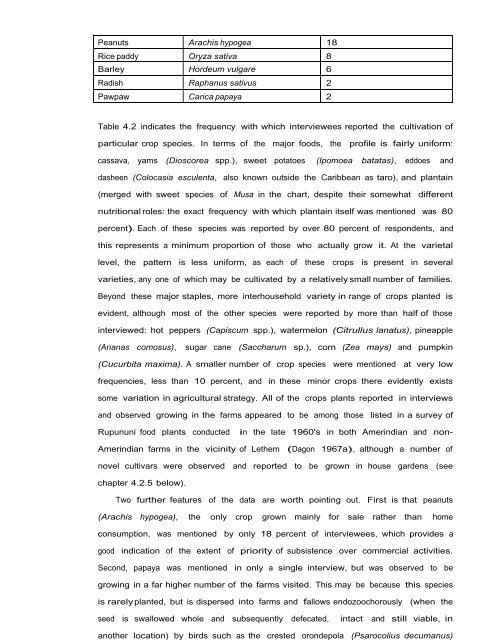Ethnoecology, Resource Use, Conservation And Development In A ...
Ethnoecology, Resource Use, Conservation And Development In A ...
Ethnoecology, Resource Use, Conservation And Development In A ...
Create successful ePaper yourself
Turn your PDF publications into a flip-book with our unique Google optimized e-Paper software.
Peanuts Arachis hypogea 18<br />
Rice paddy Oryza sativa 8<br />
Barley Hordeum vulgare 6<br />
Radish Raphanus sativus 2<br />
Pawpaw Carica papaya 2<br />
Table 4.2 indicates the frequency with which interviewees reported the cultivation of<br />
particular crop species. <strong>In</strong> terms of the major foods, the profile is fairly uniform:<br />
cassava, yams (Dioscorea spp.), sweet potatoes (Ipomoea batatas), eddoes and<br />
dasheen (Colocasia esculenta, also known outside the Caribbean as taro), and plantain<br />
(merged with sweet species of Musa in the chart, despite their somewhat different<br />
nutritional roles: the exact frequency with which plantain itself was mentioned was 80<br />
percent). Each of these species was reported by over 80 percent of respondents, and<br />
this represents a minimum proportion of those who actually grow it. At the varietal<br />
level, the pattern is less uniform, as each of these crops is present in several<br />
varieties, any one of which may be cultivated by a relatively small number of families.<br />
Beyond these major staples, more interhousehold variety in range of crops planted is<br />
evident, although most of the other species were reported by more than half of those<br />
interviewed: hot peppers (Capiscum spp.), watermelon (Citrullus lanatus), pineapple<br />
(Ananas comosus), sugar cane (Saccharum sp.), corn (Zea mays) and pumpkin<br />
(Cucurbita maxima). A smaller number of crop species were mentioned at very low<br />
frequencies, less than 10 percent, and in these minor crops there evidently exists<br />
some variation in agricultural strategy. All of the crops plants reported in interviews<br />
and observed growing in the farms appeared to be among those listed in a survey of<br />
Rupununi food plants conducted in the late 1960's in both Amerindian and non-<br />
Amerindian farms in the vicinity of Lethem (Dagon 1967a), although a number of<br />
novel cultivars were observed and reported to be grown in house gardens (see<br />
chapter 4.2.5 below).<br />
Two further features of the data are worth pointing out. First is that peanuts<br />
(Arachis hypogea), the only crop grown mainly for sale rather than home<br />
consumption, was mentioned by only 18 percent of interviewees, which provides a<br />
good indication of the extent of priority of subsistence over commercial activities.<br />
Second, papaya was mentioned in only a single interview, but was observed to be<br />
growing in a far higher number of the farms visited. This may be because this species<br />
is rarely planted, but is dispersed into farms and fallows endozoochorously (when the<br />
seed is swallowed whole and subsequently defecated, intact and still viable, in<br />
another location) by birds such as the crested orondepola (Psarocolius decumanus)


